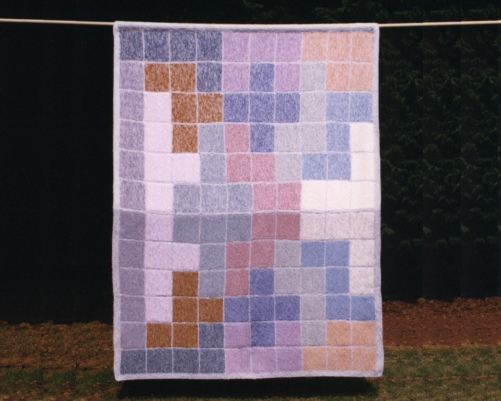




We were still playing with shapes that we were using in other ways in school. Another Maths teacher in the school was obsessed with pentominoes. He had transparent pentominoes covering the windows of his classroom. They are shapes made from five squares joined together, just as dominoes have two squares joined together. There are twelve different pentominoes and they fit together in many strange ways. They must have seeped into my brain and I wanted to knit them.
One way of fitting pentominoes together is in a rectangle. All twelve fit to make various shapes of rectangle. The total area of twelve shapes with five squares in each is sixty squares. They can be arranged in 3 x 20, 4 x 15, 5 x 12 and 6 x 10 rectangles. I didn’t like the proportions of any of these rectangles and tried to think of a possible solution. It should have been more obvious but it came to me eventually that when we work with pentominoes we always say that there are twelve possible shapes, not including reflections. If I did use reflections I could have one hundred and twenty squares. The first problem was solved but I still needed to make them look like reflections. It is very rare that Steve and I ask for anyone else’s advice but in this case the opinion of an outsider was very valuable. We got to the stage where we may have started seeing what we wanted to see but for the effect not to be clear to everyone else.
One set of pentominoes had to look like the image, the other like the reflection.
The plan was to use dark colours on one side and toning lighter shades on the other.
I frequently called on the Art teacher who was on the other side of the adjoining
door in my classroom. Several times she reinforced what I already knew. None of the
ideas I had experimented with was going to work because there was not the same amount
of difference between each pair of colours and some parts would stand out more than
others. I worked lots of small samples and it was clear that all the shapes on the
image side must be of the same brightness, or all equally dull, but that didn’t help
with what was to happen on the reflection side. I think there were more samples worked
for this than for any other design. Eventually a magical solution appeared. I had
some slightly fluffy, silver-
It was worth making the effort to get it right. I hung Bunch of Fives on the wall and one pupil after another came in and said ‘It’s a mirror’ and had no difficulty in recognising reflections. It taught us yet another mathematical lesson. Reflection, in the mathematical sense, is extremely difficult for some pupils to grasp. Textbooks usually have the image and reflection shown in the same colour, or just in outline. When they see slightly different shades pupils can readily accept that they are looking at what they might see in a mirror. This was an unexpected bonus from our revised plan.
